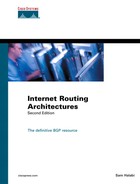Frequently Asked Questions
Q— I statically defined a default toward my provider by pointing toward a network I am learning via BGP. What happens if that network goes up and down?
A— Your default will appear and disappear. That is why you should not point your default to a specific subnet. Always point to an aggregate or supernet, because they are less likely to flip-flop.
Q— I have the option of getting the 0/0 default via BGP or defining a static default. Which do you think is best?
A— For the border router, both methods are the same as long as the aggregate you are pointing to is stable. On the other hand, after you receive the 0/0 via BGP, it will get flooded to all your IBGP peers, and there is a chance that you will end up sending it to your other EBGP peers. When you define the default statically, you will have better control.
Q— My AS is connected to two providers, one in SF and one in NY. I want the traffic from and toward my SJ site to go in and out on the SF link. All other traffic should flow over the NY link. What do I need to do to achieve this behavior?
A— Because there are two different providers, MEDs should be used. The only methods are AS path manipulation (or perhaps methods such as those proposed in RFC 1998) for inbound traffic and local preference manipulation for outbound traffic. For your inbound traffic toward San Jose, you can use the AS path manipulation technique to make your path longer for all SJ routes advertised on the NY link. The problem is with your outbound traffic. If you know exactly what networks the SJ users are trying to reach, you can give those destinations better local preference on the SF exit. If the SJ site needs to reach any destination, setting a better local preference on the SF link will cause all your outbound traffic to leave via the SF link. However, that doesn't meet your requirement for the NY link to carry all other traffic.
Another way of dealing with this scenario is policy routing, in which a router can track source addresses and direct traffic accordingly. This is described in Chapter 8, "Controlling Routing Inside the Autonomous System."
Q— I am prepending AS numbers to my routes to tip the balance of my traffic. I am not seeing any effect. Why?
A— Remember that your updates are exchanged by multiple providers. A provider along the way can use local preference to override your path length. Check with your provider.
Q— Do I have to set BGP policies? Why can't I leave it to BGP to figure out the correct path?
A— You do not have to set policies. Remember, though, that BGP is not taking into account the speed of your links and your user traffic requirements. If you are happy with your traffic pattern the way it is, you do not need to change any attributes.
